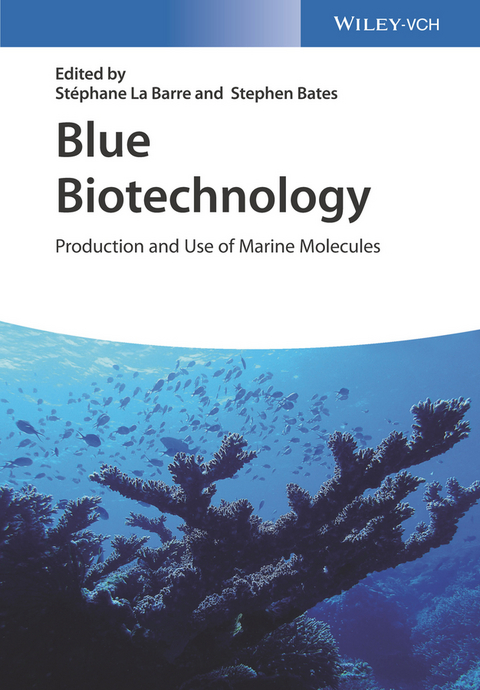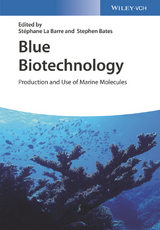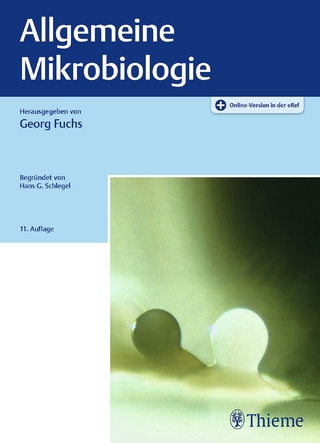Blue Biotechnology
Wiley-VCH (Verlag)
978-3-527-34138-2 (ISBN)
Stéphane La Barre is a Senior Research Scientist retired from the French Centre National de la Recherche Scientifique. He obtained his MSc. degree from Auckland University, New Zealand, and his PhD from James Cook University (Townsville, Australia), before entering CNRS in 1984. His multi-disciplinary career includes marine chemical ecology, natural products chemistry of terrestrial and marine organisms and polymer chemistry. Stéphane was coordinator of the research cluster BioChiMar (Marine Biodiversity and Chemodiversity), and is currently developing research on new analytical tools to evaluate and predict environmental changes on coral reef diversity, both biological and chemical. Stephen S. Bates is a Scientist Emeritus with Fisheries and Oceans Canada (DFO). He obtained his MSc. Degree in Marine Biology from the City College of New York, and his PhD in Biological Oceanography from Dalhousie University (Halifax, Canada). He has held post-doctoral positions at the University of Quebec (INRS-Eau), the Bedford Institute of Oceanography (Dartmouth, NS), and the National Research Council (Halifax, NS). His research has centered on the physiological ecology of marine phytoplankton, with special interests in methods for assessing their growth and physiology. At DFO, his specialty has been the physiological ecology of harmful algal blooms, especially those diatom blooms that produce the neurotoxin, domoic acid, which causes amnesic shellfish poisoning.
PART 1 BULK MARINE BIOMASS - INDUSTRIAL APPLICATIONS AND POTENTIAL AS PRIMARY SOURCES
Microalgae: A Renewable Source for Food and Fuels and more
Commercial-Scale Production of Microalgae for Bioproducts
Ubiquitous Phlorotannins: Prospects and Perspective
The Potential of Microalgal for Biotechnology: A Focus on Carotenoids
Applications of Algal Biomass in Global Food and Feed Markets: From Traditional Usage to the Potential for Functional Products
Phytoplankton Glycerolipids: Challenging but Promising Prospects from Biomedicine to Green Chemistry and Biofuels
Bioremediation Potential of Algae: Recycling Nitrogen, Phosphorus and other Waste Products
Cultivation and Conversion of Tropical Red Seaweed into Food and Feed Ingredients, Agricultural Biostimulants, Renewable Chemicals and Biofuel
PART 2: MARINE MOLECULES FOR DISEASE TREATMENT / PREVENTION AND FOR BIOLOGICAL RESEARCH
Use of Marine Compounds to Treat Ischemic Disease
Bioinspiration from Marine Scaffolds
Guanidinium Toxins: Natural Biogenic Origin, Chemistry, Biosynthesis and Biotechnological Applications
Carrageenans: New Tools for New Applications
Peptide Antibiotics from Marine Microorganisms
Recent Developments and Chemical Diversity of Cone Snails with Special Reference to Indian Cone Snails
Marine Polysaccharides and their Importance for Human Health
Marennine-Like Pigments: Blue Diatom or Green Oyster Cult?
Bioprospecting and Insights into the Biosynthesis of Natural Products from Marine Microalgae
Ovothiol: A Potent Natural Antioxidant from Marine Organisms
Bioactive Marine Molecules and Derivatives with Biopharmaceutical Potential
Marine Pigment Diversity: Applications and Potential
Potential Applications of Natural Bioactive Cyanobacterial UV-Protective Compounds
Bio-Inspired Molecules Extracted from Marine Macroalgae: A New Generation of Active Ingredients for Cosmetics and Human Health
Emerging Therapeutic Potential of Marine Dinoflagellate Natural Products
How Fluorescent and Bioluminescent Proteins have Changed Modern Science
PART 3: BIOSTRUCTURES, BIOMATERIALS AND BIOMOLECULES FOR OTHER APPLICATIONS
Antimicrobial and Antibiofilm Molecules Produced by Marine Bacteria
Chitin of Poriferan Origin as a Unique Biological Material
Marine Biominerals with a Biotechnological Future
| Erscheinungsdatum | 19.05.2017 |
|---|---|
| Verlagsort | Weinheim |
| Sprache | englisch |
| Maße | 170 x 244 mm |
| Gewicht | 2172 g |
| Themenwelt | Naturwissenschaften ► Biologie ► Mikrobiologie / Immunologie |
| Naturwissenschaften ► Chemie ► Technische Chemie | |
| Technik ► Maschinenbau | |
| Schlagworte | Biomaterial • Biomaterialien • biomaterials • Biopharmaceuticals & Pharmaceutical Biotechnology • Biopharmaceuticals & Pharmaceutical Biotechnology • Biopharmazeutika u. Pharmazeutische Biotechnologie • Biopharmazie • Biotechnologie • Biotechnologie i. d. Biowissenschaften • Biotechnologie i. d. Chemie • Biotechnology • Biowissenschaften • Chemie • Chemistry • Life Sciences • Materials Science • Materialwissenschaften |
| ISBN-10 | 3-527-34138-2 / 3527341382 |
| ISBN-13 | 978-3-527-34138-2 / 9783527341382 |
| Zustand | Neuware |
| Informationen gemäß Produktsicherheitsverordnung (GPSR) | |
| Haben Sie eine Frage zum Produkt? |
aus dem Bereich




